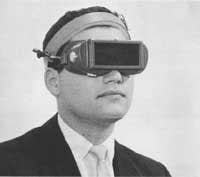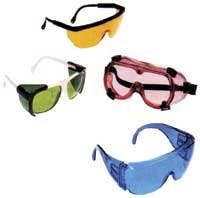In the 40 years since 1965, coverage of laser safety in Laser Focus World has grown progressively from an initial focus on safety devices and procedures for laboratory environments to a much broader range of real-world issues, such as the widely publicized recent arrest of an amateur astronomer by the U.S. Department of Homeland Security for alleged reckless and irresponsible use of a hand-held laser pointer.
In his Laserscopeeditorial column in theJan. 15, 1965, issue, editor Bill Bushor was speaking primarily about laboratory conditions when he wrote, "In our opinion much more could be done to define the dangers, specify the safeguards, and disseminate the safety information relative to laser health hazards. We solicit your comments on this topic. If our readers know of any existing codes other than those stated here, please forward them to our editorial office . . ." The general nature of the two codes included in Bushor's editorial article indicated the relatively vague state of the art of laser safety atthe time, as well as the cause for his concern.
In Aug. 1, 1965, Bushor expressed a hope that consistently publishing information about laser health hazards would help offset something that he referred to as LASIT, or "Laser Allusions Stimulated by Incoherent Thinking."
Articles in several issues throughout that first year of publication followed the progress of a laser warning sign proposed as an international standard by Jack de Ment of the Laser Research Laboratory at the Dental School at the University of Oregon in Portland (see Fig. 1). And an item in the Nov. 1, 1965, issue described laser-safety eyeshields "speciffcally designed for persons working with ruby, neodymium, and calcium tungstate lasers."
But they're ugly
The effectiveness of eyewear in preventing injuries proved to be limited, however, because many people didn't put them on. "The most frequent cause of laser-related eye accidents is the user not wearing safety eyewear-even when eyewear was available," wrote LFW editor Yvonne Carts, 30 years after Bushor's 1965 editorial (Laser Focus World, May 1995, p. 223).
In subsequent coverage, a large part of the problem was attributed to the fact that traditional safety goggles grew hot and uncomfortable when worn for long periods, and also to the fact (believe it or not) that traditional safety goggles generally did not complement a fashionable appearance. So in addition to improving protective features of laser-safety eyewear, by the mid-90s the industry was also providing a variety of styles and colors of eyewear, as well as comfort features such as lighter weight, oexibility, cushioned temples, and the ability to be worn over prescription glasses (see Fig. 2; Laser FocusWorld, August 1998, p. 149).
Even with the availability of fashionable, comfortable eyewear and established standards, such as the American National Standard Institute (ANSI) Z136 series of laser-safety standards, it was still the case that, as Bushor had put it, "more could be done." In the same August 1998 article written by Karl Heljik of the Laser Institute of America (LIA) and Gordon Miller of Lawrence Livermore National Laboratory (LLNL; Livermore, CA) described a three-tiered safety system of engineering, administrative, and personal protection procedures. Engineering control items included beam enclosures and interlocks. Administrative controls included flashing lights, signs, and an intercom system. Personal controls included protective clothing, such as eyewear, as well as communication of safety procedures.
In the world
While much has been done to address Bushor's concerns in 1965, a whole new range of concerns has arisen as lasers moved out of the laboratory and into applications as diverse as light shows, laser pointers, and military weaponry. In 1995, laser light shows put on by hotels near the airport in Las Vegas, NV, caused incidents of laser illumination of aircraft and disruption of aircrew procedures. It took almost five years of work between the aviation industry, the federal government, and the laser industry for appropriate safety guidelines to be established and accepted (Laser Focus World, October 1999).
Five years later concern over hazards to air traffic posed by ground-based lasers has again become a public issue because of the availability of green laser pointers, previous public concern over the abuse of red laser pointers (Laser Focus World, September 1998, page 63), sensitivity to suggestions of possible terrorist activity, and the fact that aircrews generally have not yet become accustomed to this relatively new source of potential distraction, (Laser Focus World, March 2005, p. 54).
One area that presents a somewhat different approach to laser safety is the area of optical communication networks, in which safety features must be designed into the system to protect users, who would not be expected to take safety precautions or even to be aware of system malfunctions or disconnections that might cause exposure to laser radiation (Laser Focus World, May 1999, page 285).
In the 40 years since 1965, coverage of laser safety in Laser Focus World has grown progressively from an initial focus on safety devices and procedures for laboratory environments to a much broader range of real-world issues, such as the widely publicized recent arrest of an amateur astronomer by the U.S. Department of Homeland Security for alleged reckless and irresponsible use of a hand-held laser pointer.
Beam unto others, before they . . .
Another aspect of laser safety arises in the prospect of optical warfare, in which the idea is to inflict damage unto others while preventing them from inflicting damage unto you. An article describing a laser-safety program at Brooks Air Force Base (San Antonio, TX) that was concerned with the effects of glare from laser guidance and weapons systems on the performance of pilots or ground personnel (Laser Focus World, September 2000, p. 141).
Because the 20% transmission ratio of laboratory laser eyewear would not work for a military aviator trying to read cockpit instruments while flying at night, materials with enhanced laser reflection and visual wavelength transmission must be sought out instead. Optical quality must eliminate any haze or distortion even when flying at low altitudes and high speeds. And the structural design of eyewear must be compatible with helmets, oxygen masks, and ejection seats.
Impressive.
I wonder what Bill Bushor would have had to say about that.
- FIGURE 1. A laser-safety sign designed by researchers at the University of Oregon Dental School and the Children’s Hospital Research Foundation (Cincinnati, OH) in the mid-1960s was proposed for use as an international standard (top). A laser-safety eye shield introduced in 1965 by TRG, a subsidiary of Control Data Corporation (Melville, NY), used Schott-BG-18 filter glass and was designed to provide eye protection from low- and medium-energy pulses at wavelengths from 690 to 1200 nm (bottom).
- FIGURE 2. Laser-safety eyewear development has included attention to fashion and comfort to increase the percentage of people who actually wear it when they are supposed to.

